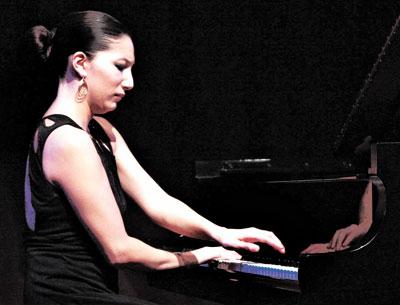Opinion: An Elegant Piano Recital

A piano recital by Tanya Gabrielian on Saturday marked the beginning of the 10th anniversary season of the Rising Stars piano series at the Southampton Cultural Center.
Ms. Gabrielian has performed on four continents and in many top-name venues, has won a number of highly respected competitions, and recently completed studies at the Juilliard School as the only candidate accepted for the artist diploma program, which is a very selective postgraduate residency program.
But perhaps even more interesting is her Art for Activism initiative, which, among other things, attempts to combat the stigma of mental illness. Projects have included an installation with the artist Fran Bull for the exhibit “In Flanders Field: A Meditation on War,” and Ms. Gabrielian has founded a biweekly interactive performance series for patients at the New York State Psychiatric Institute in New York City. For this work she was awarded the 2011 McGraw-Hill Robert Sherman Award for music education and community outreach.
She says on her Web site that although many artists have dealt with mental health issues, she is troubled by the misconception that great art can be created only from suffering and pain. Making reference to this in her opening comments on Saturday, she said she was there to entertain, and indeed the evening was filled with pleasure of the highest order.
Each performer has a different personality, of course, that comes across in the playing, interpretation, and choice of repertory. One pianist may be strong and fiery, another passionate, another turbulent and unsettled, or another virtuosic. While Ms. Gabrielian’s concert had these qualities in some measure, it was characterized above all by elegance and poise.
The opening of the recital was J.S. Bach’s “French Suite No. 2,” which consists of six short movements mostly based on dance forms. Ms. Gabrielian’s tone was beautifully and evenly voiced, making each line clear and bringing out the inner voices with fine coloring.
I will admit to the heresy that Haydn is not on my top-10 list of composers, but some of his piano sonatas could convince me otherwise. His “Sonata in E flat,” next on the program, was played with beautiful transparency and refinement. The second movement, Adagio e Cantabile (in a singing style), was a standout for its sensitivity. Ms. Gabrielian took the many disparate melodic and rhythmic elements and molded them into one in a way that was more graceful than is sometimes heard.
The closing movements of both the Bach and the Haydn — a gigue and a minuet, each rendered in a highly stylistic manner by the composers — are not big or dramatic by design, and these choices perhaps gave an insight into the performer’s temperament. But it was clear from the enthusiastic response that the audience was fully captivated and transported.
Moving to a very different kind of music, Ms. Gabrielian next chose three of Sergei Rachmaninoff’s “Etude-Tableaux” (Study Pictures). Rachmaninoff wrote two sets of these, and we heard Nos. 2, 3, and 7, Op. 33. It is believed that each etude was inspired by some visual stimulus, but in most cases the composer intentionally chose not to reveal the source.
I think it doesn’t really matter, because the visual aspect was not the ultimate goal of the music. Perhaps it’s even better that we don’t know, because in Rachmaninoff’s unique harmonic and textural style the aural images can involve the listener fully without needing a visual reference.
Ms. Gabrielian handled the high technical demands of these etudes with ease, but, more important, the incredible multilayered translucent textures had a sublime shimmer to them. The dictionary defines translucent as allowing light, but not detailed images, to pass through, and this is a fitting description of this music, given its aforementioned visual-aural nature.
For me, Etude No. 3 was a favorite, with its tranquil, sustained, yet ever-changing character. No. 7, which the composer did say was inspired by a country fair, was a delight. Here we heard some of the more vigorous and buoyant fortissimo sounds of the piano. Against the more restrained parts of the program, these qualities stood out in great contrast, and at the end it brought some hearty bravos from the listeners.
For a closing, Ms. Gabrielian chose Franz Liszt’s setting of the Waltz from “Faust” — from the happy parts of “Faust,” she emphasized. Again she showed fabulous technique along with insightful playfulness. In a couple of spots the music nearly thundered with the compelling waltz rhythm, showing that for her the technique can be held in reserve, and used at the command of the music.
After this, the calls from the audience for an encore couldn’t be denied. We were treated to a song by Mikhail Glinka, “The Lark,” as transcribed for piano by Mily Balakirev.
There are eight more events in the Rising Stars anniversary celebration, going until December 2013, including two duo concerts; most performers have been heard as Pianofest participants. Next up is Margarita Shevchenko on Nov. 10. The concerts begin at 7 p.m. on Saturdays, and stay roughly within a one-hour format, allowing for an early evening or other plans. An added bonus is that there are video screens on each side of the auditorium, so that anyone who cannot see the keyboard or performer well can get an unobstructed view from the screens. Tickets are $15.
More information is at southamptonculturalcenter.org. More about Ms. Gabrielian and her Art for Activism initiative can be found at tanyagabrielian. com.
